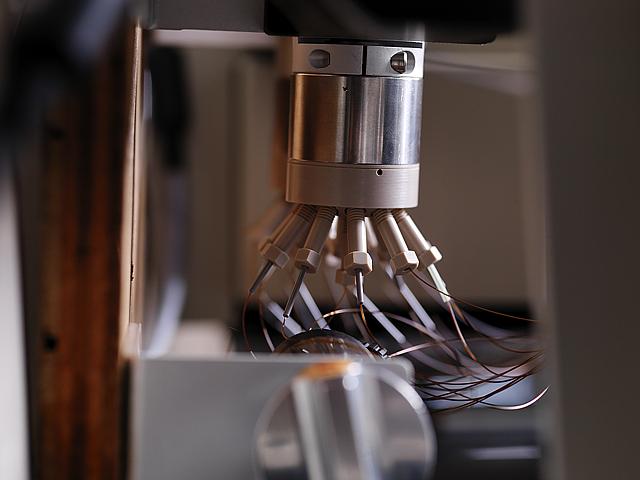Introduction
Significance of Mass Spectrometry in Bioanalysis
Mass spectrometry (MS) has emerged as a foundational technology in bioanalytical research, offering unprecedented insights into the structure, composition, and function of biological molecules. It enables the precise identification and quantification of molecules, ranging from small metabolites to complex proteins and nucleic acids. In the context of organizations operating in the bioanalytical realm, understanding the capabilities and applications of MS is crucial for advancing scientific discoveries, drug development, clinical diagnostics, and personalized medicine.
Objectives of the White Paper
This white paper aims to provide a comprehensive overview of mass spectrometry as it pertains to organizations in the bioanalytical field. It delves into the principles, technological advances, and diverse applications of MS, emphasizing its critical role in drug discovery, clinical diagnostics, biomarker research, and personalized medicine. By the end of this paper, readers will gain a profound understanding of how MS can be harnessed to drive innovation, solve complex challenges, and improve human health in the bioanalytical context.
Principles of MS
Principles of Mass Spectrometry
Mass-to-Charge Ratio (m/z)
MS operates on the fundamental principle of separating ions based on their mass-to-charge ratio (m/z). This allows for precise determination of molecular weights and structural information.
Ionization Techniques
Various ionization techniques, such as electrospray ionization (ESI) and matrix-assisted laser desorption/ionization (MALDI), enable the conversion of analytes into ions for analysis.
Mass Analyzers
Different mass analyzers, including quadrupole, time-of-flight (TOF), and Orbitrap, offer unique advantages for resolving ions based on their m/z values.
Detection and Data Analysis
Sophisticated detection systems and data analysis software are essential for accurate quantification and structural elucidation of molecules.
Advances in MS
Technological Advances in Mass Spectrometry
High-Resolution MS
High-resolution MS enables precise mass measurements, improving the accuracy of compound identification and quantification.
Tandem Mass Spectrometry (MS/MS)
MS/MS techniques allow for the fragmentation and sequencing of molecules, facilitating the identification of complex biomolecules and metabolites.
Quantitative MS
Quantitative MS methods, such as multiple reaction monitoring (MRM), enable the precise quantification of analytes in complex biological matrices.
Imaging Mass Spectrometry
Imaging MS provides spatial information about the distribution of molecules within tissues, aiding in biomarker discovery and drug localization studies.
Drug Discovery
Applications in Drug Discovery
Mass Spectrometry plays a pivotal role in various stages of drug discovery, offering precise and sensitive analytical capabilities that aid pharmaceutical researchers in making informed decisions. The following sections highlight key applications of MS in drug discovery:
Targeted and Untargeted Screening
MS is widely used for targeted screening of potential drug candidates and their metabolites. Researchers employ MS assays to quantitatively assess the concentration of specific compounds within complex biological matrices. This targeted approach is instrumental in identifying lead compounds, understanding their pharmacokinetic properties, and optimizing their efficacy.
In addition to targeted screening, MS is employed for untargeted screening to discover novel drug candidates. Untargeted MS analyses allow researchers to explore the entire chemical composition of biological samples, identifying unexpected compounds that may exhibit therapeutic potential. This approach is particularly valuable for identifying biomarkers and potential drug targets.
ADME (Absorption, Distribution, Metabolism, Excretion) Studies
ADME studies are crucial in understanding how drugs are absorbed, distributed, metabolized, and excreted within the body. LC-MS/MS is instrumental in assessing drug pharmacokinetics, bioavailability, and metabolic pathways.
Absorption: LC-MS/MS quantifies drug concentrations in blood plasma or serum, providing insights into drug absorption rates and bioavailability.
Distribution: By analyzing tissue and organ samples, researchers can determine the distribution of drugs within the body.
Metabolism: LC-MS/MS aids in identifying drug metabolites and their pharmacological activities. It is particularly valuable in characterizing Phase I and Phase II metabolism.
Excretion: LC-MS/MS assists in assessing drug excretion rates and routes, essential for optimizing dosing regimens.
Pharmacokinetics and Bioavailability
Pharmacokinetic studies rely heavily on LC-MS/MS for quantifying drug concentrations in various biological matrices over time. LC-MS/MS allows researchers to generate concentration-time profiles, facilitating the determination of crucial pharmacokinetic parameters such as clearance, half-life, and area under the curve (AUC). These insights are vital for establishing safe and effective dosing strategies during drug development.
Moreover, LC-MS/MS plays a pivotal role in assessing drug bioavailability, which is the fraction of the administered drug that reaches the systemic circulation unchanged. Bioavailability studies, often conducted via LC-MS/MS, guide formulation development to enhance drug absorption and bioavailability.
Drug Metabolism and Pharmacokinetics (DMPK)
Drug Metabolism and Pharmacokinetics (DMPK) studies are integral to understanding how drugs are processed in the body and how their pharmacological properties are influenced. LC-MS/MS is a cornerstone technology in DMPK research, offering unparalleled sensitivity and selectivity for characterizing drug metabolism and pharmacokinetics.
Quantitative Analysis of Drug Compounds
MS enables precise and quantitative analysis of drug compounds and their metabolites in various biological matrices, including blood, urine, tissue, and plasma. The ability to measure drug concentrations accurately throughout the drug development process is essential for optimizing dosage regimens, assessing bioavailability, and ensuring therapeutic efficacy.
Pharmacokinetic Studies
Pharmacokinetic studies rely on MS to determine how drugs are absorbed, distributed, metabolized, and excreted in vivo. Researchers track drug concentration-time profiles, allowing for the calculation of pharmacokinetic parameters such as clearance, volume of distribution, and half-life. These parameters guide dosing regimen design and help predict drug behavior in clinical settings.
Biomarker Analysis
MS is invaluable in identifying and quantifying biomarkers associated with drug responses, toxicity, and disease states. Biomarker analysis assists in understanding the pharmacodynamics of drugs and predicting patient responses. MS can simultaneously quantify multiple biomarkers in complex biological samples, providing valuable insights into drug efficacy and safety.
Proteomics and Targeted Drug Development
In proteomics, MS identifies and quantifies proteins, facilitating target identification and validation for drug development.
Small Molecule Analysis
MS is used to analyze small molecules, including metabolites and lipids, providing insights into cellular pathways and disease mechanisms.
Clinical Diagnostics
Clinical Diagnostics and Personalized Medicine
Biomarker Discovery and Validation
MS is instrumental in biomarker discovery and validation, aiding in the diagnosis and monitoring of diseases.
Disease Diagnosis and Monitoring
MS-based assays are employed for clinical diagnosis, enabling the detection of specific biomarkers associated with various medical conditions.
Therapeutic Drug Monitoring
In personalized medicine, MS assists in optimizing drug therapies by monitoring drug levels in patient samples and adjusting treatments accordingly.
Challenges
Challenges and Solutions
Sensitivity and Specificity
Enhancing sensitivity and specificity is a constant challenge in MS-based bioanalysis, requiring advancements in instrumentation and sample preparation techniques.
Sample Preparation
Optimal sample preparation methods are crucial for accurate MS analysis, involving extraction, purification, and derivatization steps.
Data Interpretation
Interpreting complex MS data necessitates advanced data analysis algorithms and bioinformatics tools.
Standardization and Quality Control
Standardized protocols and quality control measures are essential to ensure reproducibility and accuracy in MS-based bioanalysis.
LIMS and ELN
Advantages of LIMS and ELN Integration
Laboratory Information Management Systems (LIMS) and Electronic Laboratory Notebooks (ELN) offer several advantages when integrated into bioanalytical processes within organizations:
Streamlined Data Management: Both LIMS and ELN systems provide centralized platforms for efficient data storage and retrieval. LIMS ensures that critical data is readily accessible, reducing the time and effort required for data retrieval, while ELN replaces paper-based records with digital, searchable formats, enhancing data recording and management.
Data Accuracy and Integrity: LIMS and ELN systems enhance data accuracy and integrity. LIMS enforces data integrity through features like audit trails and electronic signatures, reducing the risk of errors and data manipulation. ELNs support real-time data entry, reducing the chances of transcription errors and ensuring that recorded data is accurate and up-to-date.
Regulatory Compliance: LIMS and ELN systems can be configured to align with regulatory requirements, facilitating compliance with bioanalytical regulations. They enable the creation of compliant reports and documentation and can include checklists and templates to ensure that bioanalytical procedures adhere to regulatory guidelines.
Enhanced Data Analysis: Both systems provide tools for data analysis, enabling organizations to gain deeper insights from their bioanalytical data. They support trend analysis, statistical reporting, and efficient data analytics, aiding in proactive decision-making.
Collaboration and Knowledge Sharing: LIMS and ELN systems foster collaboration by allowing multiple teams and stakeholders to access and contribute to bioanalytical data. They promote cross-functional communication and knowledge sharing.
Improved Efficiency and Productivity: LIMS and ELN systems automate routine tasks, reducing manual data entry and administrative overhead. This leads to improved efficiency and faster response times. Researchers can allocate more time to research and analysis, increasing overall productivity.
Data Security and Accessibility: Both systems offer robust data security measures, including user access controls and data encryption. This ensures that sensitive bioanalytical data is protected from unauthorized access, and secure access controls prevent data breaches.
Scalability and Flexibility: LIMS and ELN systems can be scaled and tailored to accommodate the growing data volumes and evolving research requirements associated with bioanalytical projects. They adapt to changing laboratory and research needs.
Cost Savings: While initial implementations of LIMS and ELN may involve investments, they can lead to significant cost savings in the long run. These systems reduce manual labor, minimize errors, and improve operational efficiency. ELN implementations also offer cost savings through reduced paper and storage costs while contributing to research efficiency, potentially accelerating bioanalytical discoveries and product development.
In summary, the integration of Laboratory Information Management Systems (LIMS) and Electronic Laboratory Notebooks (ELN) offers numerous advantages to organizations in the bioanalytical realm. These systems enhance data management, integrity, and compliance while promoting collaboration, efficiency, and cost savings. By implementing LIMS and ELN solutions, organizations can further optimize their bioanalytical efforts, strengthen their commitment to quality, compliance, and scientific advancement, and ultimately improve healthcare outcomes.
Future Directions
Advancements in MS Technology
Continued advancements in MS technology will lead to higher sensitivity, faster analysis, and improved accessibility.
Integration with Other Omics Technologies
Integration with genomics, transcriptomics, and proteomics will provide a holistic view of biological systems.
AI-Powered Innovations
The integration of Artificial Intelligence (AI) into MS workflows represents a transformative future direction. AI-driven data analysis, predictive modeling, and quality control promise to streamline drug development, enhance analytical precision, and expedite the discovery of novel pharmaceutical compounds. These AI-driven advancements are set to redefine the landscape of pharmaceutical research and development.
Expanding Applications in Life Sciences
The versatility of MS will lead to new applications, further advancing research in life sciences.
Conclusion
In conclusion, mass spectrometry is a cornerstone technology in bioanalytical research and applications within organizations in the life sciences sector. Its principles, technological advancements, and diverse applications are pivotal for drug discovery, clinical diagnostics, biomarker research, and personalized medicine. As MS continues to evolve and expand its capabilities, it will drive innovation and significantly impact the field, ultimately improving healthcare outcomes and our understanding of biological systems. Organizations in the bioanalytical realm are encouraged to embrace MS as an indispensable tool for addressing complex challenges and advancing scientific discoveries.




